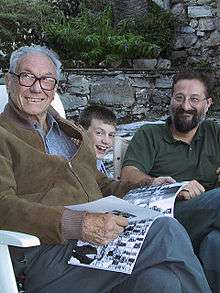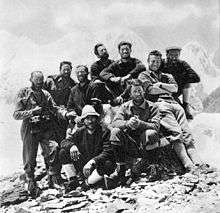Fosco Maraini
| Fosco Maraini | |
|---|---|
 | |
| Born |
15 November 1912 Florence, Italy |
| Died |
8 June 2004 (aged 91) Florence, Italy |
| Nationality | Italian |
| Fields | Ethnology of Tibet and Japan |
| Influences | Giuseppe Tucci |
Fosco Maraini (15 November 1912 – 8 June 2004) was an Italian photographer, anthropologist, ethnologist, writer, mountaineer and academic.
Biography
As a photographer, Fosco Maraini is perhaps best known for his work in Tibet and Japan. The visual record Maraini captured in images of Tibet and on the Ainu people of Hokkaidō has gained significance as historical documentation of two disappearing cultures. His work was recognized with a 2002 award from the Photographic Society of Japan, citing his fine-art photos—and especially his impressions of Hokkaido's Ainu. The society also acknowledged his efforts to strengthen ties between Japan and Italy over 60 years. Maraini also photographed extensively in the Karakoram and Hindu Kush mountain ranges of Central Asia, in Southeast Asia and in the southern regions of his native Italy.

As an anthropologist and ethnographer, he is known especially for his published observations and accounts of his travels with Tibetologist Giuseppe Tucci during two expeditions to Tibet, first in 1937 and again in 1948.[1]
As a mountaineer, he is perhaps best known for the 1959 ascent of Saraghar[2] and for his published accounts of this and other Himalayan climbs.[3] As a climber in the Himalayas, he was moved to describe it as "the greatest museum of shape and form on earth."[4]
From 1938 to 1943, Maraini's academic career progressed in Japan, teaching first in Hokkaido (1938–1941) and then in Kyoto (1941–1943); but what he himself observed and learned during those years may be more important than what he may have taught. Dacia, his eldest daughter, would decades later recall that "the first trip I took was on the sea from Brindisi to Kobe."[5] Two of his three daughters were born in Japan: Yuki was born in Sapporo in 1939, Antonella (Toni) in Tokio in 1941. After the Italians signed an armistice with the allies in World War II, the Japanese authorities asked Maraini and his wife Topazia Alliata to sign an act of allegiance to Mussolini's puppet Republic of Salò. They were both asked separately and separately they refused, and were interned with their three daughters of six, four and two years old in a concentration camp at Nagoya for two years.[6] Those memories of 1943 through 1946 evolved into some chapters of the book "Meeting with Japan" by Fosco Maraini. Dacia Maraini's collection of poetry drawn from those difficult years, Mangiami pure, was published in 1978.[7]
The Maraini family retreated to Italy after the Americans occupied Japan. This period became the core of another book by Dacia Maraini who remembers that they left Asia "without either money or possessions, stripped bare, with nothing on our backs except the clothes handed out by the American military."[8] The years in Italy are described in the book, Bagheria, named after the Sicilian town not far from Palermo where the family lived.[8]
In time, Maraini did return to his "adopted homeland" of Japan; and in 1955, this journey of rediscovery became the basis for his book, Meeting with Japan.[9]
In an interview, one of his daughters explained that one of her earliest memories of her father speaking is when he claimed:
Remember that races don't exist, cultures exist.[5]
The head of the Tuscany regional government publicly explained that Maraini had "honored Florence and the Tuscany by teaching us to be tolerant of other cultures."[10]
Fosco Maraini was, with Giuliana Stramigioli among others, a founding member of the AISTUGIA – the Italian Association for the Japanese Studies.
The 1963 film Violated Paradise, directed by Marion Gering was based on Maraini's work L' Isola Delle Pescatrici (1960).[11] A few images shot by Maraini's crew were used in the production.[12]
Selected works
Maraini has had numerous photographic exhibitions in Europe and Japan; and he wrote over twenty books, many of which have been translated into several languages.
Books
- Secret Tibet (1952)
- Ore Giapponesi (1959)
- G4-Karakorum (1959)
- Meeting with Japan (1960)
- L'Isola delle Pescatrici (1960)
- Paropàmiso (1963). English version: Where Four Worlds Meet: Hindu Kush 1959 (1964)
- Tokyo (1976)
- The Island of the Fisherwomen (1962)
- Jerusalem: Rock of Ages (1969), Photography by Alfred Bernheim and Ricarda Schwerin; Translated by Judith Landry; New York: Harcourt, Brace and World, Inc.
- Patterns of Continuity (1971)
- Gnosi delle Fànfole (1994)
- Nuvolario (1995)
- Case, amori, universi (2000)
Articles
- "Tradition and Innovation in Japanese Films," Geographical Magazine. Oct. 1954: 294–305.
Honors
- Photographic Society of Japan, International Award—2002.[13]
- Japan Foundation Award—1986,[14]
- Order of the Rising Sun, 3rd class—1982.[15]
- International Society to Save Kyoto's Historic Environment, (ISSK) – First Honorary President.
See also
Notes
- ↑ Maraini, Fosco. (1994). "Tibet in 1937 and 1948," Government of Tibet in Exile web site.
- ↑ Carlo Pinelli, fellow climber in 1959. Mountain Wilderness web site.
- ↑ Karakorum, K-2 climb.
- ↑ trekker web page, just one example of the oft-repeated Maraini quote.
- 1 2 Centovalli, Benedetta. (2005). "Interview, Dacia Maraini", Words without Borders web site.
- ↑ Maraini bio note. Life in Legacy web site.
- ↑ Dacia Maraini (1936), bio. Italia Donna web site (in Italian).
- 1 2 Marcus, James. " Broken Promises," New York Times. 9 April 1995.
- ↑ "From Sukiyaki to Storippu," Time. 4 January 1960.
- ↑ "Il gonfalone della Toscana a Dacia Maraini in memoria del padre scomparso," Servizi radiofonici Regione Toscana. 8 June 2004.
- ↑ Goble, Alan (1999). The Complete Index to Literary Sources in Film. Walter de Gruyter. p. 306. ISBN 978-3-11-095194-3.
- ↑ "l isola delle pescatrici" [The Island of the Fisherwomen] (in Italian). Asiatica Film Mediale. Retrieved September 19, 2015.
- ↑ PhotoHistory 2002.
- ↑ Japan Foundation Awards (1986)
- ↑ Rogala, Jozef. A Collector's Guide to Books on Japan in English: A Select List of Over 2500 Titles with Subject Index, p. 144.
References
- Lane, John Francis. Obituary, "Fosco Maraini, Italian Explorer and Travel Writer Who Brought His Understanding of the East to the West," The Guardian (Manchester). 15 June 2004.
- Obituary, "Fosco Maraini, Writer and Traveller Who Photographed 'Secret Tibet'," The Independent (London). 19 June 2004.
- Obituary, "Fosco Maraini: Dauntless Italian travel writer who devoted himself to exploring Asian civilisations, and once lopped off a finger to prove his courage," Times (London). 29 June 2004.
- Rogala, Jozef. (2001). A Collector's Guide to Books on Japan in English: A Select List of Over 2500 Titles with Subject Index. London: Routledge. ISBN 1-873410-80-8
External links
- Official website
- Dacia Mariani website (Italian)
- Dacia Maraini's bio (in Italian)—referencing father
- Dacia Maraini's bio (in English)—referencing father
- Toni Maraini's bio (in Italian)—daughter's bio, referencing father
- Marilyn Silverstone—photographer influenced by Maraini
- Japan Mint: 2004 International Coin Design Competition – see competitor design, "Homage to Fosco Maraini, famous Italian anthropologist, orientalist, writer and photographer"... also see "Excellent Work" plaster model, Maurizio Sacchetti (designer)